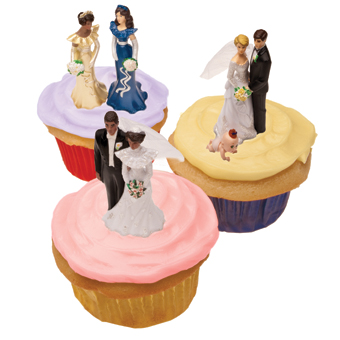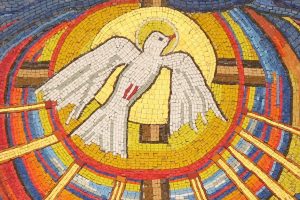Careers, children, cohabitation—this isn’t your parents’ path to the altar.
Emily Barnak remembers a term that one of her cousins devised years ago to refer to a common reality among young adults and their significant others: LIS. Short for “living in sin.” As in, “Are you LISing?” It comes in handy at family gatherings, when the 20- and 30-something cousins catch up on one another’s lives and relationships but don’t want to distress older relatives who would surely disapprove if they knew.
Barnak, 27, is engaged to be married. She met her fiancé, Casey, when they were serving in the Jesuit Volunteer Corps. According to plenty of statistics, Barnak is like the majority of her peers in a few important ways: She pursued her education and career before marriage, and she expects to have a good marriage and family life. After graduate school necessitated a long-distance relationship for a few years, Barnak made a cross-country move to be with Casey.
And like the majority of engaged couples in the United States-Catholic and otherwise-the two moved in together, at least for a while. When she finally found work as a physician’s assistant several months after relocating, her new job was too far for a daily commute from their home in Denver, effectively keeping her from “LISing” during the week.
While Barnak and her fiancé have been contemplating their coming marriage, the U.S. bishops have also been doing a lot of contemplation about the institution as a whole. They launched the National Pastoral Initiative for Marriage in 2004. And just last November the bishops issued “Marriage: Love and Life in the Divine Plan,” a pastoral letter that focuses on the meaning of marriage, the challenges the institution currently faces, how marriage is a blessing for all society, and how the sacrament and vocation of marriage can lead to greater holiness in individuals, couples, and families.
Not surprisingly, most young adult Catholics didn’t get the letter, so to speak.
Barnak, for instance, disagrees with or questions several church teachings about marriage: the prohibition of artificial birth control, the naming of cohabitation as objectively sinful in nature, and the impossibility of same-sex marriage.
“What it comes down to, for me, is Jesus,” she says. “The Jesus I know through prayer and Bible study is one who welcomes everyone to the table. It seems the church has a lot of rules about who is welcome and who is not.”
A failure to communicate
She’s got a lot of company, according to Gail Risch, who has taught the theology of marriage to hundreds of Catholic college students at Creighton University in Omaha. Most know coming into the course what the church teaches-no sex before marriage, no birth control, no same-sex unions-but they want to know why.
“Today’s young adults ask questions,” says Risch. “They want to know the rationale behind the teaching. They do not settle for ‘because I said so.'”
When her students delve into the church’s argument against contraception, for instance, the typical response she hears is, “ ‘You’ve got to be kidding!’ They would say it’s reasonable and responsible to use reliable contraception. The large majority outright reject official church teaching in Humanae Vitae.”
And when it comes to teaching on homosexuality and marriage, “Most of them are appalled-they have friends or family members who are engaged in same-sex relationships, and [the church’s teaching] is terrible discrimination from their perspective.”
The fact that many young adult Catholics disagree with some aspects of the church’s teachings likely disappoints the bishops, but Risch does have some good news: When her students read what the church has to say about love and marriage in Gaudium et Spes, “they buy that 100 percent. They’re delighted to hear that official church teaching. They’re totally into commitment.”
As to whether cohabiting couples are truly “into commitment,” Risch says in her experience most who identify as Catholic are either already engaged or are considering marriage, as opposed to cohabiting couples that have no plans to marry. “There’s more of an attitude that marriage is lifelong, and that divorce is out of the question. It’s a very healthy and hopeful shift.”
Baby on board
Still, even among some young adult Catholics who have been happily living together, feelings of guilt or uneasiness can sometimes surface as they go through marriage preparation or have conversations with priests, deacons, or other pastoral staff on their way to the altar.
Shelby and Derek Cook saw that firsthand when they attended the marriage prep program through the Diocese of Pembroke in Canada before their wedding this past May. The Cooks had already been married civilly and had a young son before they started preparing for their Catholic ceremony.
“I was worried that people at the course would judge me,” says 25-year-old Shelby.
Still, when others were tightlipped in their group sessions, she says, “Usually I would get the conversation going by saying that we already had a child and lived together.” Soon others started opening up-it turned out all but one of the 23 couples in the class were living together, and some had children, either together or from previous marriages.
“Sometimes couples don’t realize that the church is not trying to be a punitive ‘bad guy,’ but rather wants to help the couple establish the strongest foundation possible for a lasting marriage,” says Susan Vogt, editor of the Journal of the National Association of Catholic Family Life Ministers and content editor for the bishops’ website ForYourMarriage.org .
“The job of the marriage minister-whether it’s a priest, deacon, or couple-is to help the engaged couple understand the depth of Catholic teaching. We know through generations of church teaching, reinforced by modern science and human reason, that the sexual relationship between a man and woman is best protected and enhanced through the permanent commitment of marriage,” Vogt says.
She adds, however, that when a couple’s experience and church teaching conflict, the wise pastoral minister “does as Jesus did. He or she remembers the prodigal son and the woman at the well-and errs on the side of love. A strong welcome is the first step. The teaching can follow.”
Vogt says this approach is particularly appropriate for working with sexually active couples, which are the great majority today. “They are coming to the church wanting to make their relationship whole and holy. They want to move from sex outside of marriage and make their relationship right through a sacramental union. This is a graced opportunity. It is not our job to judge the couple’s worthiness-only God can do that. We do need to help them become aware of the import of this decision and that it is just the first step on a long journey of faith and love.”
No path to the altar
Other Catholic couples won’t be found in an Engaged Encounter weekend or Pre-Cana class because they’re not eligible for marriage in the church.
Leilani and Nancy Taylor have been together for 10 years, and their relationship has been recognized with three domestic partnerships (for each state they’ve lived in), plus legal and religious wedding ceremonies. Along with all other marriages performed for same-sex couples in San Francisco in 2004, theirs was later declared void by the state supreme court. Although same-sex couples are no longer able to marry in California, the Taylors retain legal status from a second ceremony in 2008. They have a 2-year-old daughter and attend Our Lady of Lourdes Parish in Oakland.
“There’s so much I admire about the church,” says Leilani, 31, who became Catholic when she was 18 after being raised atheist. (“I attended one Mass, and I knew this was it,” she says.) But of church teaching on marriage, she says, “there’s so much about the role of the husband and the role of the wife that I don’t even want to begin to try to apply it because it doesn’t apply. I do try to see if there’s something to hold onto. What I keep is the idea that marriage is for life and that it’s about more than just romantic love and that God is there to help us through the rough times of marriage.”
She acknowledges that much of church teaching on this topic is difficult for her-especially when the bishops’ pastoral letter calls same-sex unions one of the four “fundamental challenges to the nature and purposes of marriage,” along with contraception, divorce, and cohabitation.
“Sometimes I wonder if I’m being a pushover in wanting it to apply when they don’t even want it to apply,” she says.
Leilani believes young people are likely to ignore the church’s positive messages about marriage and family if the church doesn’t recognize the integrity of families that “look a little different.” “The church could learn a lot about love from the way people are arranging their families and lives,” she says.
When Leilani and Nancy served as godparents for a niece, the baptism had to be done privately rather than during a regular Mass. Parishioners weren’t able to witness the baptism and help celebrate with and support the family. And that, for Leilani, is a double-whammy of disappointment: “I really think the church is doing a disservice to kids of nontraditional families, and to others-even if they want to say I’m a sinner.”
Even many young adult Catholics in traditional marriages accept nontraditional relationships. Laura Cordero (who asked to use an alias since she teaches at a Catholic high school) and her husband have been married for seven years. They live in Los Angeles and have a young son. “I think the church has a lot to offer when it talks about making a commitment to one person, but we’re losing that because the church is constantly focusing on a person’s sexuality and on what constitutes marriage-that it be exclusive to couples that are heterosexual,” she says.
In graduate school, she took a class on spirituality and sexuality, and she remembers her professor talking about how the church and our experience must be informed by each other. These insights ring especially true in her work as a religion teacher at a Catholic high school: “When I see students disengaged with their faith, it’s because they think the church doesn’t listen.”
And while she was a virgin before she got married at 22-well below the average age of 25 for Catholic women and 27 for Catholic men, according to research from the Center for Applied Research in the Apostolate (CARA)-“I’m not sure that it would have been the same situation if we were getting married now.” For that reason, Cordero says, “The sexuality of single people should be discussed and honored [by the church] because as a society we’re telling people they should be in their late 20s before they get married. But the church is only talking about abstinence, and that’s just not where people are when they’re 29.”
Rites of passage
When marriage is postponed until certain economic and educational milestones are reached, the wedding itself can take on epic proportions, Andrew J. Cherlin writes in his 2009 book, The Marriage Go Round: The State of Marriage and Family in America Today (Knopf): “An observer sometimes gets the sense that what matters to some young adults is not so much being married as getting married-that the exercise is more about status than survival.”
For some couples, part of the “status” comes from having a big church wedding, regardless of their actual involvement in a parish. That can be a real irritation for parish staff dealing with the couple and their family members, but many young adult Catholics see real value in parishes bending a little to accommodate their peers: “Even when couples are getting married in the Catholic Church more out of tradition [than out of their current commitment], I still think it’s good because it keeps the door open for them,” says Shelby Cook.
That worked for Todd and Julie Zasada, who stopped going to Mass a few years after their church wedding. When their marriage started floundering, though, they knew they could get help from the church (see sidebar).
Friendships within their parish, American Martyrs in Manhattan Beach, California, and their conviction that God is present in their relationship also fortify Jay and Laurie Perreault’s 10-year marriage. “Marriage is hard enough when faith is present,” says Jay, 39, but keeping God in the mix “helps stack the deck in your favor.”
He says that marriage has helped him recognize the sacredness of life and the importance of the sacraments, including confession. “When I was in my early 20s I didn’t give a hoot about confession,” he says. But now, “I really want to live a holier life.”
Life lessons
That’s something that the bishops want to happen, too. But that’s a tall order. Over and over, young adult Catholics interviewed for this story articulated that didn’t know as much as they wanted to about “the riches of our Catholic faith” when it came to marriage-nor had they ever been presented with them until they actively pursued marriage prep.
“You don’t learn about Catholic marriage in school, so this course explained a lot and helped me with my own beliefs and questions,” Shelby Cook says about her three sessions of marriage preparation.
While Barnak and her fiancé have found meeting with a counselor and spiritual director worthwhile, she says she wishes she had directly encountered the church’s teaching on marriage earlier. “I went to church every Sunday and went through CCD and the sacraments-but I never felt the opportunity to engage [the church’s teaching on marriage and relationships],” she says. “Almost everything I learned by observing. . . . I didn’t really have anyone talking to me about faith and relationships at that point.”
But she did have one conversation with her grandmother back in college that stuck with her. At one point her grandmother said, “You really have to think and pray about what you’re going to bring to the altar.”
“It was the first time anyone had shared something like that with me,” Barnak says. She wishes that more young Catholics would have that question asked in the context of their faith: “How is the way you’re living your life now going to affect you when you’re preparing for that sacred relationship later?” She thinks that approach might hook young adults for whom the idea of marriage is far off their radar screen.
“For a lot of young adults, relationships are an outlet, just like alcohol and drugs, and they can be just as destructive. They can be a way to escape family problems and insecurities, and give a sense of self-worth.” If the church were better at addressing that with young people in a non-guilt-inducing way, “that might encourage a lot of people to think about their weekend hook-ups in college,” Barnak says. “The beauty of our faith is that we believe in a forgiving God.”
Cordero says she and her husband wanted to “get as much as we could” during their marriage prep, and they did indeed receive plenty of support: the FOCCUS pre-marriage inventory; a retreat with a marriage therapist; meetings with her husband’s father, a Methodist pastor, as well as with a Catholic deacon and the priest who married them.
They were also assigned a sponsor couple who had been married more than 30 years. “That was a wonderful way to have someone to ask questions of and to understand more about marriage,” she says. “They continue to be a great resource for us.”
When she thinks about her young son and his prospects for marriage and family in a couple of decades, she’s hopeful. “I hope that he can have what I was offered,” she says. “I would be excited if he found a loving partner. And I would hope our church would support his loving union, in whatever way that looks.”
This article appeared in the September 2010 issue of U.S. Catholic (Vol. 75, No. 9, pages 12-17.)
Image: Tom Wright














Add comment